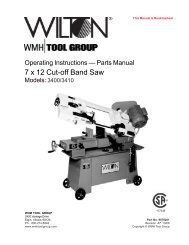This Rigger's Handbook is dedicated to Theodore C - Igor Chudov
This Rigger's Handbook is dedicated to Theodore C - Igor Chudov
This Rigger's Handbook is dedicated to Theodore C - Igor Chudov
You also want an ePaper? Increase the reach of your titles
YUMPU automatically turns print PDFs into web optimized ePapers that Google loves.
General Information<br />
In reeving a pair of tackle blocks, one of which has across the edges of the block shell.<br />
more than two sheaves, the ho<strong>is</strong>ting rope should lead<br />
from one of the center sheaves of the upper block.<br />
To reeve by th<strong>is</strong> method, the two blocks should be<br />
placed so that the sheaves in the upper block are at<br />
When so reeved, the ho<strong>is</strong>ting strain comes on the right angles <strong>to</strong> those in the lower one, as shown in the<br />
center of the blocks and they are prevented from following illustrations. Start reeving with the becket, or<br />
<strong>to</strong>ppling, with consequent injury <strong>to</strong> the rope by cutting standing end, of the rope.<br />
It <strong>is</strong> good practice <strong>to</strong> use a shackle<br />
FIGURE 1 FIGURE 2 FIGURE 3 FIGURE 4 block as the upper one of a pair and a<br />
hook block as the lower one. A<br />
shackle would prevent any accidental<br />
d<strong>is</strong>engagement of the block from its<br />
attaching point in the event of an<br />
unusual movement of the attaching<br />
point or block. The lower block having<br />
a hook <strong>is</strong> more readily attached or<br />
detached from the load. See Figures 1<br />
through 5.<br />
DOUBLE AND<br />
DOUBLE<br />
TRIPLE AND<br />
DOUBLE<br />
THE REEVING OF TACKLE BLOCKS<br />
TRIPLE AND<br />
TRIPLE<br />
VARYING SHEAVE REVOLUTIONS IN A PAIR OF TACKLE BLOCKS<br />
To ra<strong>is</strong>e a load one foot, the lower block must be ra<strong>is</strong>ed one foot, and in accompl<strong>is</strong>hing<br />
th<strong>is</strong>, each working rope must be shortened one foot.<br />
In the example above, Ropes 1, 2, 3, etc., must be shortened one foot <strong>to</strong> ra<strong>is</strong>e the load<br />
one foot. Assuming that the circumference of each sheave <strong>is</strong> one foot, Sheave No.1<br />
must make one revolution <strong>to</strong> shorten Rope No. 1; Sheave No. 2 must make one<br />
revolution <strong>to</strong> take up the one foot slack form Rope No. 1 and one additional revolution<br />
<strong>to</strong> shorten Rope No. 2; Sheave No. 3 must make two revolutions <strong>to</strong> take up the two<br />
feet of slack from Ropes 1 and 2 and one additional revolution <strong>to</strong> shorten Rope No. 3,<br />
etc. for each succeeding sheave.<br />
Viz: Rope No. 1 must travel one foot on Sheave No. 1.<br />
Rope No. 2 must travel two feet on Sheave No. 2.<br />
Rope No. 3 must travel three feet on Sheave No. 3.<br />
Rope No. 4 must travel four feet on Sheave No. 4.<br />
Rope No. 5 must travel five feet on Sheave No. 5.<br />
Therefore, all the sheaves in a set of blocks revolve at different rates of speed. Sheave No. 2 rotates twice as fast<br />
as No. 1, Sheave No. 3 rotates three times as fast as No.1, Sheave No. 4 four times as fast as No. 1, etc.<br />
Consequently the sheaves nearest the lead line, rotating at higher rates of speed, wear out more rapidly.<br />
All sheaves should be kept well lubricated when in operation <strong>to</strong> reduce friction and wear.<br />
HEADQUARTERS: 55 James E. Casey Drive • Buffalo, NY 14206 PHONE: 716.826.2636 FAX: 716.826.4412 www.hanessupply.com<br />
136<br />
QUADRUPLE<br />
AND TRIPLE<br />
YOUR SLING AND RIGGING SPECIALIST<br />
FIGURE 5<br />
SHEAVE<br />
NO. 5<br />
SHEAVE<br />
NO. 1<br />
SHEAVE<br />
NO. 2<br />
SHEAVE<br />
NO. 4<br />
SHEAVE<br />
NO. 3
















